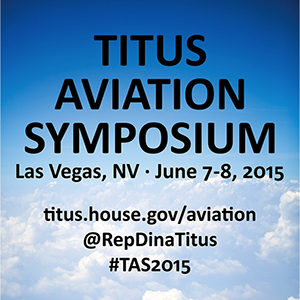Las Vegas — Rep. Dina Titus held her first Titus Aviation Symposium today here in her district, where speakers and panelists addressed the many challenges facing the aviation industry, including the integration of unmanned aircraft into the national airspace.

Unmanned Aviation Panel L-R – Brian Wynne, President & CEO of AUVSI; Patrick Stoliker, deputy director of NASA’s Armstrong Flight Research Center; George Guerra, VP Northrop Grumman; Rep. Dina Titus; FAA Administrator Michael Huerta; Brad Hayden, President & CEO of Robotic SKies; Reza Karamooz, President NVBAA; not pictured, Tom Hallman, President, PictorVision
“This is kind of the future of the industry, and I think Nevada has a role to play a part of that story,” she said.
She fought to get the state one of the six UAS test sites selected by the Federal Aviation Administration, a point keynote speaker FAA Administrator Michael Huerta noted.
“She called me about it on more than one occasion,” he said.
Huerta said the agency is currently gearing up for the next FAA reauthorization bill, which will need to be passed by Sept. 30, 2015. The last reauthorization was extended by Congress 23 times and took four and half years to finish.
“We can certainly do better than that, and we must,” he said.
Huerta discussed the FAA’s efforts to put out a final rule on small unmanned aircraft systems integration, for platforms weighing 55 pounds or less. His team is working through the 4,500 comments submitted to the draft version of the rule and said the FAA would take a risk-based approach that lets the organization respond to user demand while maintaining its priority to safety.
He addressed the unique ability of Nevada’s UAS test site to play a role in the roadmap of rolling out UAS. It is the only of the six test sites that can grant an airworthiness certificate for experimental aircraft.
“Effectively, they act as us in granting that certificate,” he said.
Huerta announced the FAA plans to hold a public meeting in Nevada later this year to discuss how to create more opportunities for the test sites, an issue addressed during a panel discussion on UAS led later that day by AUVSI President and CEO Brian Wynne. The panel included experts from industry and NASA.
Attendee Bruce Tarbert, from the Nevada UAS Test Site Program Management Office, expressed frustration to the panel that the exemptions the FAA is giving to small UAS operators, who are seeking business opportunities currently not allowed otherwise, have wider operational authorizations than the test sites. He also said many private companies are unwilling to hand their aircraft over to a federal entity for testing.
“I really can’t understand how a railroad has better qualifications than any of the six test sites to conduct beyond-line-of-sight R&D efforts. It doesn’t make sense to me,” he said, taking a jab at the FAA’s Pathfinder Program, which recently tapped BNSF Railway.
Wynne discussed the opportunities the industry has to address issues like Tarbert’s and also deal with regulatory issues and the myriad other factors hampering UAS integration.
Brad Hayden, of Robotic Skies, an aviation repair company, said the line between hobbyists and commercial operators is bound to get further defined, especially by the price of platforms but also but the need for insurance.
“What’s driving our business more than regulations … we’re adding value, and what’s happening is the insurance companies are coming to us saying we need to get these things inspected. We need to put these on a plan, or we’re just not gong to insure them,” he said.
Tom Hallman, from PictorVision, which has a Section 333 exemption to use UAS in filmmaking, said the word is getting out about legal versus illegal commercial flight operations. He said that a large company recently selected PictorVision after dropping a different production company because the moviemakers realized the original company was not authorized to fly.
“What we’re really after is we already have a great culture of innovation, and we know that will continue to drive forward,” Wynne said. “What we really want is a culture of safety and a culture of compliance.”

